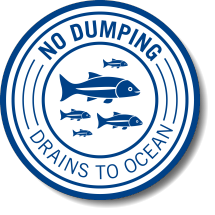By Aileen Buckley, Esri Cartographer
 A new try-it-yourself-for-free project been posted on the Learn ArcGIS web site! In the No Dumping – Drains to Ocean project, you’ll learn how to find the area that contributes to a storm drain and the route that pollutants will take if they are dumped or washed into the drain. You’ll find the upstream drainage area, called a watershed, for a storm drain near Blackman Elementary School in Tennessee. Then you’ll find the downstream flow path, called a trace, to where it empties into the Gulf of Mexico. Knowing how to find these, you can experiment to find the watersheds and flow paths for other storm drain locations.
A new try-it-yourself-for-free project been posted on the Learn ArcGIS web site! In the No Dumping – Drains to Ocean project, you’ll learn how to find the area that contributes to a storm drain and the route that pollutants will take if they are dumped or washed into the drain. You’ll find the upstream drainage area, called a watershed, for a storm drain near Blackman Elementary School in Tennessee. Then you’ll find the downstream flow path, called a trace, to where it empties into the Gulf of Mexico. Knowing how to find these, you can experiment to find the watersheds and flow paths for other storm drain locations.
Project Workflow: Create a point layer for the storm drain using Map Notes. Create a default watershed. Note that it is small, so rerun the analysis using the search distance setting to find the larger upstream watershed. Explore the map to see where the watershed is located. Create the downstream flow path (trace). Examine the table to see its length in miles. Add a field and calculate it to show the length in kilometers. Explore the map to see where the trace flows.
- Author: Aileen Buckley
- Platform: ArcGIS Online
- Time: 45 minutes
- Level: Beginner (also appropriate for grades 9 to 12)
- Skills: Create Watersheds and Trace Downstream online analysis tools
- Geography: Anywhere you want, but the example is for a storm drain near Blackman Elementary School in Murfreesboro, Tennessee
Build skills in these areas:
- Using ArcGIS Online spatial analysis tools to find watersheds and flow paths
- Sharing your web map with others
Lessons:
- Explore the issue.
- Find out about storm water pollution and set expectations for the analyses.
- Time: 5 minutes
- Create a layer for the storm drain.
- Create a layer with a point at the storm drain location.
- Time: 10 minutes
- Create watersheds for the storm drain.
- Create watersheds for the storm drain to see the area that contributes water to the system.
- Time: 10 minutes
- Find the downstream flow path from the storm drain.
- Create a downstream trace to see how the storm water will be routed to the ocean.
- Time: 10 minutes
- Share your map with others.
- Learn how to share your web map with others.
- Time: 10 minutes

Commenting is not enabled for this article.